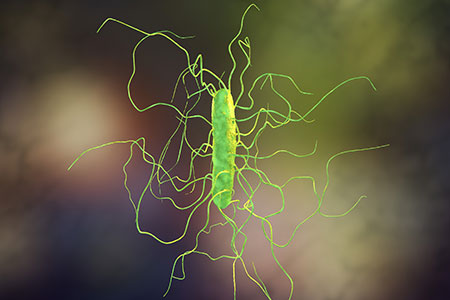 Researchers at Georgia State University made a surprising discovery1 while establishing a mouse model of C. difficile infection: a novel, endogenous strain of the bacteria which blooms after antibiotic therapy and protects its host from disease.
Researchers at Georgia State University made a surprising discovery1 while establishing a mouse model of C. difficile infection: a novel, endogenous strain of the bacteria which blooms after antibiotic therapy and protects its host from disease. This could potentially confound experimental results, as the LEM1 strain is inconsistently present among mouse model vendors.
C. difficile Genes Appearing Prior to Infection
To establish their model, the researchers treated mice with antibiotics (orally and intraperitoneally), then challenged the mice with the pathogenic C. difficile strain VPI10463. This approach induces robust manifestations of clinical disease and produces a translational model for severe intestinal infection with C. difficile in patients after antibiotic therapy.Disease penetrance in the mice was less than expected. More surprisingly, researchers found a high prevalence of tcda, the gene for C. difficile toxin A, in the feces of mice after antibiotic treatment but prior to infection.
How could these mice — seemingly negative for C. difficile — possess the tcda gene prior to infection, while also resisting disease after inoculation with VPI10463?
Isolating LEM1 via Fecal Microbiota Transplantation
Through fecal microbiota transplantation to germ-free mice, the authors established that mice resistant to infection with the pathogenic C. difficile-strain VPI10463 harbored an endogenous, non-pathogenic, and toxin-positive C. difficile strain that protected the mice from disease.Through whole genome sequencing, the authors were able to isolate and characterize a novel, endogenous C. difficile strain — LEM1 — which is initially below the detection limit in the feces of mice, but blooms after antibiotherapy.
LEM1 has a very high degree of genetic similarity with VPI10463 and shares very similar metabolic profiles. The two strains do not differ in known virulence genes, but the LEM1 strain produces lower amounts of toxin A than VPI10463.
The group consistently observed that mice resistant to disease upon antibiotherapy and infection with VPI10463 had bloomed LEM1 prior to infection, whereas mice succumbing to disease and eventually death did not exhibit detectable levels of LEM1.
Comparing C. difficile Infection in Mouse Model Vendors
Next, the group compared the performance of mice sourced from different vendors in the VPI10463-infection model. Mice from the Jackson Laboratory and Charles River Laboratories bloomed LEM1 following antibiotic treatment, and such blooms correlated with lack of disease in response to VPI10463 infection.Mice sourced from Taconic Biosciences did not bloom LEM1 and exhibited high mortality in the infection model.
While it is acknowledged that animal model microbiomes differ between vendors, this may also apply between barrier rooms within the same vendor. The variability in LEM1 status may therefore not be consistent across all breeding colonies of a given vendor, and can reflect even more local differences.
Conclusions and Further Research
Altogether the results from Georgia State University highlight several intriguing points:- The discovery of the toxin-positive, non-pathogenic LEM1 strain in mice able to prevent disease from pathogenic C. difficile constitutes a potential for further mechanistic studies and therapeutic targeting.
- The observation of endogenous C. difficile in mice blooming after antibiotherapy challenges the widely-held assumption that infection with C. difficile in patients is always due to exposure to C. difficile spores. Some cases may be due to blooming of low-abundance, endogenous C. difficile.
- The importance of using highly sensitive methodologies that can detect different strains of C. difficile — in mouse experiments as well as in the clinical situation.
- The importance of knowing the baseline microbiota of mice used in C. difficile-infection models. The model read out may be greatly influenced by the presence of specific innocuous organisms in the baseline microbiota, and this may be source-dependent.
- The Influence of the Microbiota on Immune Response
- How to Harness the Microbiome - Considerations and Implications of the Microbiome in Preclinical Research with Reproducible Results















.jpg)

.jpg)
.jpg)
.jpg)
.jpg)





.jpg)


.jpg)
.jpg)

.jpg)


.jpg)





.jpg)

.jpg)




